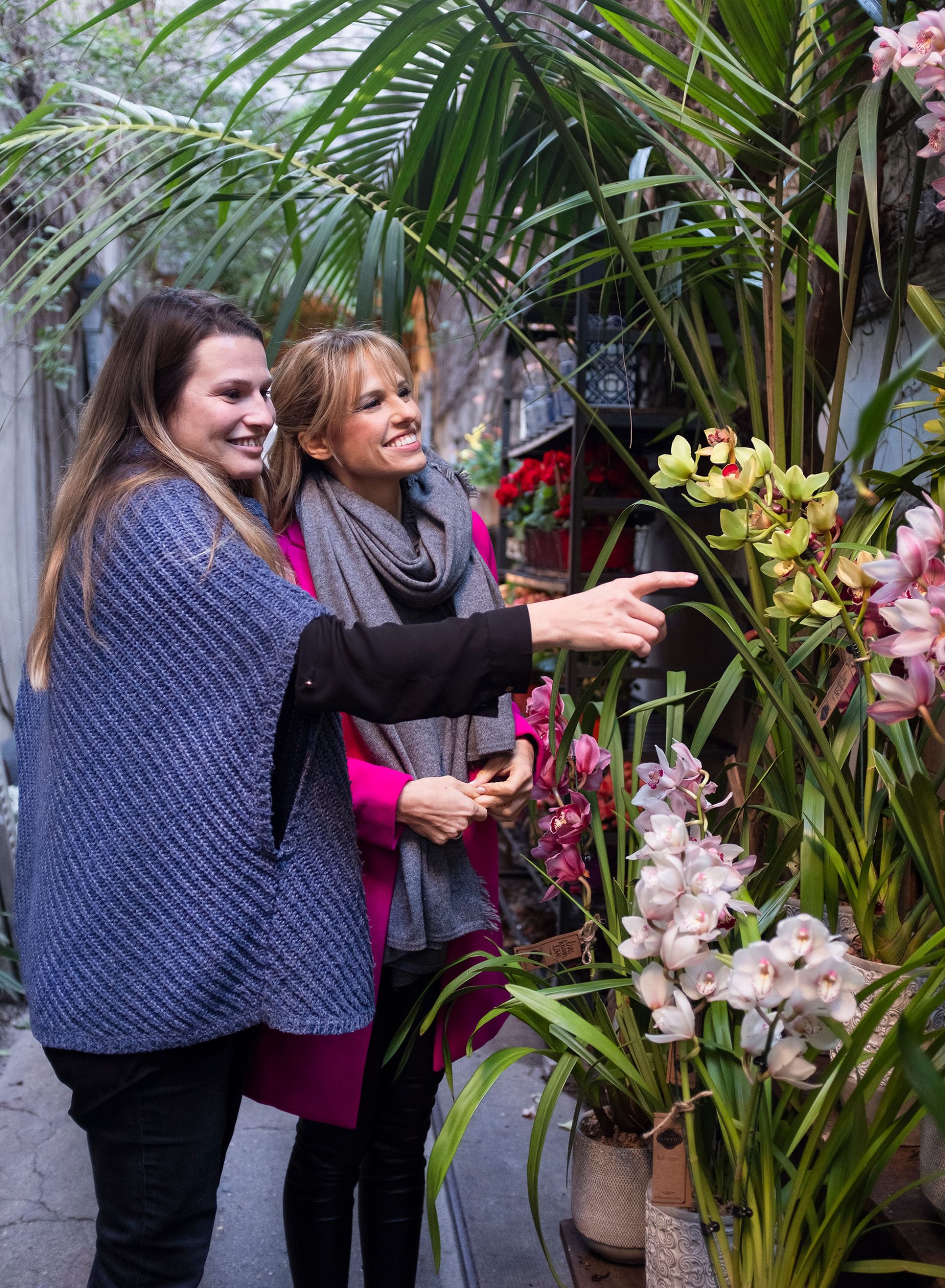Orchids, with their captivating blooms and exotic beauty, bring a touch of elegance to any home. But many shy away from these stunning plants, intimidated by their care requirements. Fear not! While they have a reputation for being delicate, caring for an orchid at home and enjoying its incredible flowers is easier than you might think. With a little insight, you can recreate an environment similar to their natural habitat and enjoy their splendor for years to come.
Recreating the Tropics: Temperature & Humidity
Imagine for a moment the lush, tropical forests from which orchids originate. Warm, humid, and dappled with shade, right? That’s the environment they crave!
1. Temperature: Orchids enjoy warmth, ideally between 68-80°F (20-27°C). Think of a comfortable temperature for wearing a T-shirt indoors – perfect for orchids too!
2. Humidity: As denizens of the rainforest, orchids yearn for a humid environment. You can easily increase humidity by placing the pot on a tray filled with pebbles and a bit of water (ensuring the pot doesn’t sit directly in water). A humidifier is another excellent option, especially during winter when indoor heating can dry out the air.
The Watering Dilemma: Less is More
If there’s one thing that can make an orchid sad, it’s overwatering. It’s always better to err on the side of too dry rather than too wet.
-
Observe the Substrate: Before reaching for the watering can, check the potting mix. Gently press your finger into the top inch of the mix. If it feels almost dry, it’s time to water. If it’s still damp, wait a couple more days.
-
Water Wisely: Rainwater or distilled water are the best choices, as they lack the chlorine and minerals found in tap water that can accumulate and harm orchid roots.
-
Watering Technique: When you water, focus on the soil around the base of the plant, avoiding the leaves and the crown (where the leaves meet the stem). This helps prevent diseases.
Feeding for Spectacular Blooms: Fertilizing
To fuel those spectacular blooms, your orchid needs nourishment in the form of fertilizer.
-
When to Fertilize: During the spring and summer months, their active growing period, fertilize every two weeks. In fall and winter, reduce the frequency to once a month or even less.
-
Orchid Food: Use a fertilizer specifically designed for orchids, which contains a balanced blend of nutrients. Importantly, dilute the fertilizer to half the strength recommended on the packaging to avoid burning the sensitive roots.
Basking in the Glow: The Right Light
Orchids have a love-hate relationship with sunlight. They crave brightness but direct sun can scorch their delicate leaves.
-
Finding the Sweet Spot: An east- or west-facing window is ideal, as it provides plenty of indirect light throughout the day.
-
Reading the Signs: If your orchid’s leaves darken significantly, it likely needs more light. Yellowing or reddish leaves, on the other hand, can signal too much direct sunlight.
A Comfortable Home: Choosing the Right Potting Medium
Forget regular potting soil. Orchids need a special, well-draining potting mix that allows their roots to breathe.
- The Perfect Blend: Look for a potting mix specifically labeled for orchids, usually containing ingredients like bark chips, perlite, and sphagnum moss. These materials retain just the right amount of moisture while allowing air to circulate freely around the roots.
Moving Day: Repotting
As your orchid grows, it will eventually need a roomier home.
-
Time for a Change: Ideally, repot your orchid every two to three years, or when you notice roots growing out of the drainage holes or the potting mix decomposing excessively.
-
New Digs: Choose a pot that’s just slightly larger than the previous one, with drainage holes to prevent waterlogging.
-
Fresh Start: Use fresh orchid potting mix when repotting.
Keeping Enemies at Bay: Pests & Diseases
Like all plants, orchids can be susceptible to pests like aphids, mealybugs, and spider mites. Excess moisture can also lead to fungal diseases.
-
Regular Check-ups: Get into the habit of inspecting your orchid’s leaves and flowers regularly for any signs of pests or disease.
-
Swift Action: If you detect any problems, isolate the affected plant immediately and treat it with an insecticide or fungicide specifically formulated for orchids, following the manufacturer’s instructions carefully.
Bonus Tips for Orchid Mastery:
-
Support System: If your orchid has long stems and large flowers, use a stake or support to prevent them from drooping or breaking.
-
Shedding Leaves: Don’t be alarmed if your orchid drops a few leaves, especially older ones. It’s a natural part of their growth cycle.
-
Patience is Key: Orchids reward patience. Pay attention to how your plant responds to the care you provide and adjust your routine accordingly.
Following these tips will allow you to enjoy the exotic beauty of orchids in your home for years to come. And remember, each orchid is unique. Don’t be afraid to experiment and adapt these guidelines to the specific needs of your plant!
How Often Should You Water an Orchid?
You’ve mastered the basics, so let’s dive deeper into the art of watering these tropical beauties! As mentioned earlier, there’s no one-size-fits-all answer. It’s like shopping for the perfect outfit: it depends on a few factors. We’re talking about what kind of orchid you have, the size of its home (its pot), the soil it lives in (the potting medium), and the climate it’s growing in.
Think of watering your orchid like finding the sweet spot between bone dry and soaking wet. You want your orchid to take a little break between sips of water but you don’t want it to completely dry out. A good rule of thumb is to touch the top of the soil. If it feels dry, it’s probably time to give your orchid a drink.
Pro Tip: When you water your orchids, use lukewarm water and allow them to drain completely before putting them back in their spot.
To make sure you’re not drowning it with kindness (or rather, with water), stick your finger a couple of inches into the soil. If you feel any moisture, hold off a bit longer. And remember, orchids don’t like foot baths! After watering, make sure you empty any excess water from the saucer. You don’t want its roots getting soggy and developing root rot.
Now, some experts believe that watering frequency might also need tweaking depending on the time of year. You may need to water more often during warmer months and less during cooler months. But again, it all comes down to observing your plant and learning its needs.
Keep your eyes peeled for any signs of distress. If the leaves are looking wrinkly or starting to yellow, it could be a sign that your orchid needs a little more H2O. On the other hand, if the roots look mushy or brown, that could be a sign of overwatering.
Remember, it’s all about finding what works best for your orchid. With a little practice, you’ll be an orchid-whispering pro in no time!
How to Keep Your Orchids Alive & Thriving
Welcome back! Since you’re here, you probably agree that orchids are fascinating plants, but keeping them happy can feel a bit tricky. Relax, you don’t need to be a horticultural expert to succeed. Let’s continue with some simple tips to keep your orchids not just alive, but bursting with blooms!
1. Mastering the Watering Game: Less is More (Really!)
Here’s the thing: orchids aren’t like the other houseplants you may have. They evolved high up on trees, so their roots aren’t used to being waterlogged. Imagine them practically drowning if you water them too much.
The key? Let the potting mix dry out almost completely before watering again. You can stick your finger into the mix to gauge the moisture level or use a moisture meter if you want to be extra precise.
Remember, with watering, it’s better to err on the side of caution. Overwatering can lead to root rot, a death sentence for your orchid.
2. Finding the Light Sweet Spot: Like Vampires, But in Reverse
Orchids adore light, but not just any kind of light. They need bright, indirect light. Think of the light that filters through the canopy of a forest — that’s the kind they crave.
Avoid placing orchids in direct sunlight, especially during summer, as their delicate leaves can burn. An east- or west-facing window is usually a good bet. Watch your orchid for clues: if its leaves start to turn yellowish, it’s probably getting too much light.
3. The Secret Sauce: A Little Food for Your Green Friends
Like all living things, orchids need nutrients to thrive. During spring and summer, their peak growing season, it’s a good idea to fertilize them once a month.
Look for fertilizer specifically formulated for orchids, as they have different needs than other plants. And here’s an extra tip: dilute the fertilizer to half the recommended concentration. It’s better to be safe than sorry when it comes to overfertilizing.
4. A Change of Scenery: Repotting for Continued Growth
Over time, the potting mix in your orchid’s pot will break down, and the roots might become root-bound (meaning they have outgrown their container). That’s why repotting every 2 to 3 years is important.
Don’t just use any old potting soil. Look for a special orchid potting mix that is airy and well-draining. Bark chips and sphagnum moss are common ingredients in these types of mixes.
5. The Hidden Enemies: Becoming a Pest & Disease Detective
Every once in a while, give your orchids a thorough check-up to look for any signs of pests or diseases. If you spot something suspicious, act quickly!
There are specific products available to combat the pests and diseases that affect orchids. The key is not to let the problem get out of control.
Remember, caring for an orchid takes a bit of patience and observation. Every plant is unique, so don’t be discouraged if you find it a bit challenging at first.
As you get to know your orchids, you’ll learn exactly what they need to flourish and brighten your home with their vibrant blooms.
How to Revive a Dying Orchid
If you have an orchid that looks like it’s on its last legs, don’t give up hope just yet! There’s still a good chance you can bring your green companion back to life. Here are some tips to help you nurse it back to health and hopefully see it bloom again.
Reviving Your Orchid: A Step-by-Step Approach
1. Playing Detective: What’s Wrong with Your Orchid?
Before you can begin any treatment, it’s crucial to understand what’s causing the problem. Examine your orchid carefully for clues:
-
Roots:
- If the roots are soft, mushy, and dark — like they’re rotting — you’re probably overwatering.
- If the roots are dry and shriveled, your orchid could be thirsty.
-
Leaves:
- Yellowing or wilting leaves can indicate overwatering or insufficient light.
- Brown spots on the leaves might be sunburns.
-
Flowering:
- If your orchid hasn’t bloomed in ages, it could be a sign it needs more light or a change in its fertilizing routine.
2. Taking Action: Solutions for Common Problems
Once you have an idea of what’s going on, you can start taking steps to correct it:
A. Overwatering:
- Unpot the orchid carefully: Gently remove the orchid from its pot and examine the roots.
- Prune the roots: Use clean, sharp scissors to trim off any mushy, black, or dead roots.
- Repot in fresh orchid potting mix: Make sure to use a fresh batch of well-draining orchid potting mix. Never use regular potting soil!
- Water sparingly: Instead of watering on a schedule, only water your orchid when the potting mix is almost dry. You can test the moisture of the potting mix by sticking your finger into the soil.
B. Underwatering:
- Give it a good soak: Fill a container with lukewarm (not hot) water and submerge your orchid’s pot for about 30 minutes, allowing the roots to soak up the water.
- Drain well: Ensure that the water drains completely from the pot after the soak.
- Adjust watering frequency: Orchids generally prefer a deep watering but less frequently.
C. Insufficient Light:
- Find a brighter spot: Relocate your orchid to a location where it can receive bright, indirect sunlight. Avoid direct sunlight, which can burn the leaves.
- Consider artificial light: If you lack sufficient natural light in your home, you can supplement with a grow light.
D. Pests:
- Quarantine: If you suspect your orchid has pests, isolate it immediately from your other plants to prevent the infestation from spreading.
- Treatment: You can try wiping the leaves with soapy water or using an insecticidal soap or neem oil, carefully following the instructions on the product label.
- Repeat treatment: Continue treating your orchid as needed until the pest infestation is gone.
E. Diseases:
- Remove affected parts: Cut any leaves or stems that show signs of disease, using clean, sharp tools.
- Fungicide: If the disease appears to be fungal, you can treat the plant with a fungicide specifically designed for orchids.
- Ventilation: To prevent diseases in the future, make sure your orchid has adequate air circulation.
The Secret to a Happy Orchid in the Long Run
Once your orchid has recovered, you can help it stay healthy and thriving by providing the proper care:
- Smart watering: Only water your orchid when the potting mix is almost dry. The frequency will depend on factors like temperature, humidity, and the type of orchid you have.
- Humidity boost: Orchids love humidity. You can increase the humidity around your plant by misting its leaves with water or placing the pot on a tray with moist pebbles.
- Light show: Place your orchid in a location with bright, indirect light.
- Temperature control: Most orchids are happy with temperatures between 65-80°F (18-27°C).
- Nutritious meals: Feed your orchid with a diluted orchid fertilizer during the growing season (spring and summer).
- Room to grow: Every one to two years, repot your orchid into a new pot with fresh orchid potting mix.
Final Orchid Care Tips
- Patience is a virtue: Reviving an orchid can take time. Don’t get discouraged if you don’t see immediate results.
- Observe and learn: Each orchid is different. Observe how your plant responds to changes you make in its environment and adjust your care as needed.
- Don’t give up! With a little care and attention, you can help your orchid thrive and bloom for many years to come.
- Backsplash Ideas for White Cabinets: Find Your Perfect Style - November 18, 2025
- White Tile Backsplash Kitchen: A Classic and Clean Design - November 17, 2025
- Backsplash For White Cabinets: Choosing The Right Kitchen Style - November 16, 2025










